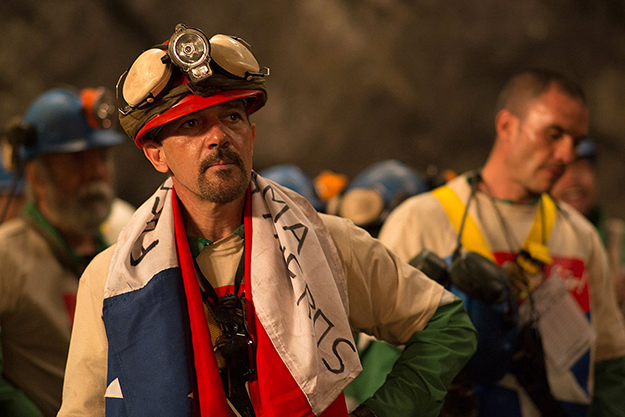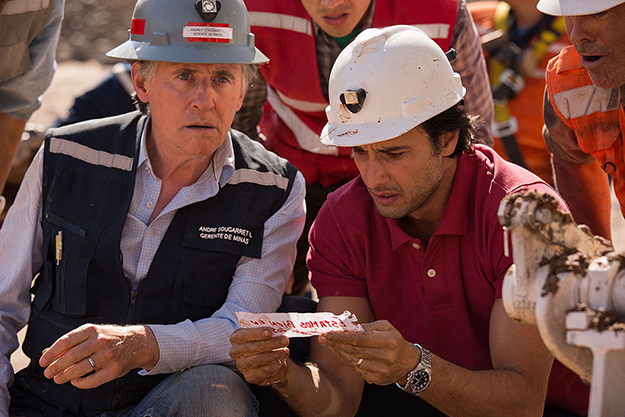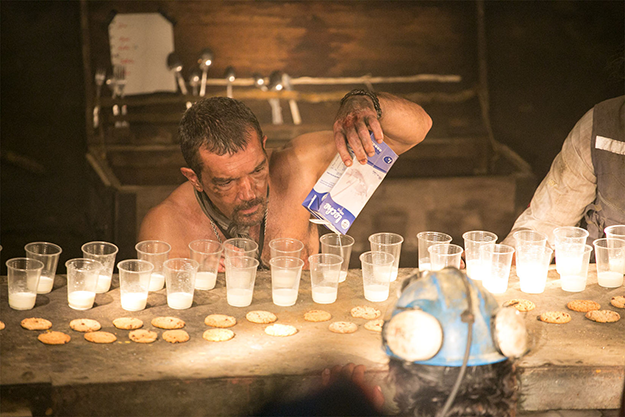Deep Focus: The 33

The 33 is a not-so-glorious throwback to the international productions of 50 or 60 years ago that would feature globe-trotting casts dramatizing historic events under the guidance of filmmakers with varying accents. The topics were often military (World War II, the Napoleonic War) and the perspective God-like. The 33 tells a story ostensibly more immediate and personal: the Chilean mine collapse in August 2010 that buried 33 miners under 2,300 feet and 770,000 tons of rock for 69 days. Yet it follows the old epic formula: 33 percent kitsch about the enduring human spirit, 33 percent Very Important Picture extravaganza featuring armies of rescuers instead of soldiers, and 33 percent absorbing re-creations of actual experiences that crumble under the weight of all the other stuff. The remaining one percent is a single stroke of inspiration—a self-contained seriocomedy of the men zoning out during what could be their Last Supper, hallucinating about their wives, girlfriends, or mothers serving them their favorite dishes. Everything in this single group reverie is freewheeling, from the use of Bellini’s Norma on the soundtrack to the spotlighted appearance of a voluptuous dairy cow. For a few minutes, a movie as square as a Stanley Kramer film becomes as buoyant as a piece of late Buñuel.
Directed by the Mexican-born Patricia Riggen, The 33 boasts the built-in curiosity value of a story that hooked audiences via TV coverage of the long-running rescue operation and the families at the nearby tent village, Camp Hope, putting pressure on the Chilean government to keep trying. The film’s drawing card is its depiction of what TV-watchers couldn’t see: life underground, from the cave-in of the San José Mine to the men’s claustrophobic climb to the surface in a slim-fit rescue capsule.
It’s unfortunate, then, that the film fritters away its novelty as well as its humanity with its oddly vague and impersonal point of view—a huge surprise considering that it was put together with the participation of the miners, as was Hector Tobar’s book, Deep Down Dark: The Untold Stories of 33 Men Buried in a Chilean Mine, and the Miracle That Set Them Free. In his acknowledgments, Tobar thanks the moviemakers for their encouragement and writes that Jose Rivera, now credited for “screen story,” “was my partner during many interviews, and his insights on the miners’ story were invaluable.” But Tobar’s book glides on billowing gusts of empathy from one character to another, while Riggen’s movie lacks any comparable élan vital.

Awkwardly and relentlessly, Riggen draws visual and emotional contrasts from three major settings—the inside of the mine, the tent city turned media circus of Camp Hope, and the fenced-in compound where giant drills promise salvation. It’s as if she’s constantly connecting, pulling apart, and reconnecting three big narrative Lego bricks.
Riggen and a trio of credited writers (Mikko Allanne, Craig Borten, and Michael Thomas) anchor each block with larger-than-life characters, like the miners’ de facto leader, “Super Mario” Sepulveda (Antonio Banderas), and a miner’s sister turned “mayor” of Camp Hope, Maria Segovia (Juliette Binoche), who makes empanadas and sells them in the streets. Other characters go through obvious growth arcs, like Laurence Golborne (Rodrigo Santoro), the inexperienced Minister of Mining who takes charge of the government’s efforts to save the miners and help their loved ones keep the faith. But without intimate, felt-out interplay with the other characters, these central characters register as star turns in a real-life story.
The supporting miners are as caricatured as the most famous miners in movie history—Snow White’s seven dwarves—though the pastor (Marco Treviño), the drinker (Juan Pablo Raba), and the ladies’ man (Oscar Nuñez) are not as engaging as Doc, Happy, and Bashful. Their stature is so small compared to Super Mario’s that when many of them complain about his need to position himself as their absolute leader, they come off as envious and petty. The most intriguing miner character is the ruminative, ineffectual supervisor, Don Lucho, but even Lou Diamond Phillips’s sensitive, slow-burning performance gets lost amid Mario’s Sturm und Drang. In light of the movie’s journalistic roots, the use of composite characters is also bizarre, especially since they’re given the names of real people. (How must it feel for Maria Segovia’s brother Dario, a family man, to see himself depicted in the movie as a homeless alcoholic alienated from his sister?) Kate del Castillo and Naomi Scott share poignant moments as Mario’s wife and daughter (respectively), and the ladies’ man’s wife (Adriana Barraza) and main mistress (Elizabeth De Razzo) engage in slapstick romantic rivalry, but in or near Camp Hope, only the drills go deep. As rescue engineer Andre Sougarret, Gabriel Byrne hits so many notes of resignation and weariness that Golborne at his glummest seems downright sunny.

Not even terrific lead actors can transcend dialogue that functions like traffic signals in language fit for billboards. “They’ll dig us out,” Mario declares to the other 32 miners in his first momentous bout of cheerleading. “If they don’t, our families will, with their bare hands if it’s necessary. I believe we’ll make it out of here because I choose to believe it. All 33 of us.” That sets the tone for Banderas’s hortatory performance. “We all know how this works,” Binoche’s Maria tells Santoro’s Golborne. “The government shows up; some good-looking guy in a suit tells us how much they care, how much they’re going to stop at nothing to save them. And they do nothing. We’re not going to stand for it.” Binoche’s spunk assures us that they won’t stand for it, while Santoro’s sensitive face reassures us that they won’t have to. The movie’s nadir is its eureka moment, when Maria tells Golborne that she “aims to please” but misses, though “not by miles.” Those simple words somehow inspire Golborne to instruct Sougarret on exactly how to adjust for the natural bending of his drill and thus break through the rock to the men. It’s like those corny, absurdly literal climaxes in composer biopics when, say, Beethoven is caught in a storm but arrives home safely so he can write the fourth movement of his Pastoral Symphony.
Physically the film is spectacular, like many international productions of yore. Cinematographer Checco Varese transforms the Atacama Desert, the mine’s location, into an eerie Martian landscape of burnt-umber sand and greenish water. (Varese has worked wonders in a grubby yet fantastical mode on TV’s The Strain.) He and Riggen put across the formidable scale of the mine beneath the mountain, which opened in 1889 and in Tobar’s words “expanded like an iceberg city.” “The Ramp,” the miners’ sole way in and out of the San Jose Mine, zigs and zags several dozen times, like a latticework streamer. The sight of dozens of men with their helmet lights on—and multiple vehicles with their headlights on—moving through mini-plateaus by the side of this labyrinthine road is scarily disorienting. Varese’s camera stays alert to textures as well as colors and shapes; the men sweat more as they come closer to the red-hot center of the earth.
Riggen does a beautiful job preparing us for the disaster. Mirrors placed within the cracks of the mine splinter, proving that the rock is moving. A cigarette suddenly flies out of a man’s hand and into the darkness behind him, as if sucked away by a newly created wind tunnel. As great slabs of stone break apart and debris starts raining down, one group of men races toward “the Refuge,” an emergency shelter usually used as a break room, which contains food and first-aid supplies, though not nearly enough. The other group tries to bust through and reach the top before getting blocked by a slab twice the weight of the Empire State Building. When all other room and road lights cease to function, the men’s helmets create loony oblique patterns in the dark.

Given the dogged power of this early sequence and other factual re-creations, like Mario’s meticulous meting-out of meager rations, it’s cruelly disappointing for Riggen to fall back on dramatic shorthand as she cuts among her three locations. She reduces the miners, in particular, to single characteristics. The young miner with a baby on the way is meant to stand for all imperiled youth, the alcoholic for all addicts and abusers. The movie climaxes too early, when Sougarret’s drill establishes a delivery route to the Refuge. From that point on, the action takes abrupt leaps and bounds. Government agencies and businesses worldwide shower the men with goods and services. They soon acquire an audio-video hookup that provides scheduled communication with their families in Camp Hope.
But Riggen rarely brings us inside their hearts and minds so we can understand their desperation. (We’re told that some of the men are bipolar or depressives who threaten to ruin the group chemistry if they can’t be brought up soon enough.) The director simplifies their conflicts to melodramatic highs and lows, like Maria’s guilt-ridden brother hiding from the camera and the telephone when she expects to speak with him, or lesser men accusing Mario of sabotaging their solidarity by considering a separate book deal (he doesn’t take it). It’s a tribute to Banderas’s conviction, not to the script, that we believe Mario when he counters them with “You’re my brothers. And if we’re going to stay brothers, we have to pull together to get out of here. Otherwise, what was the point of any of it?”
Sentimental flourishes like that one, and disaster-movie pacing—reversals and rebounds arrive like digital clockwork—sabotage the movie’s documentary power. The final shots of The 33 portray the real miners expressing their shared joy and camaraderie at a beachside reunion. It’s too bad that Riggen is less skilled at celebrating the genuine fraternity of miners than she is at conjuring fear in a cavern of crushed rock.







